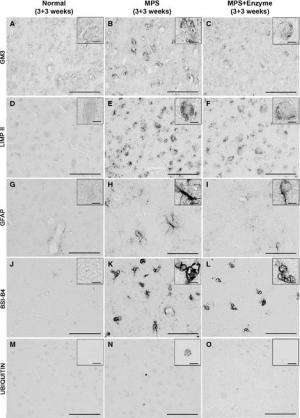This image portrays representative images of GM3 (A–C), LIMP II (D–F), GFAP (G–I), isolectin Bandieraea (Griffonia) simplicifolia (BSI-B4) (J–L) and ubiquitin (M–O) staining in the inferior colliculus of 6-week-old normal (A, D, G, J and M), MPS IIIA (B, E, H, K and N) and MPS IIIA + enzyme-treated (C, F, I, L and O) mice. The rhSGSH injection was administered at 3 weeks of age and images were taken at 3 weeks post-injection, i.e. at 6 weeks of age. Scale bar: image, 50 μm; inset, 5 μm (A–O). Credit: Wiley
A European Journal of Neuroscience study suggests that it is critical to treat lysosomal storage disorders early, before symptoms arise. These genetic disorders, which are caused by the malfunction of enzymes that normally degrade various substances within cells, lead to numerous ailments including neurological problems.
Although few therapeutic options are available, clinical trials of treatments including lysosomal enzyme replacement are underway. Researchers who used enzyme replacement to treat mice with early, mid- and later-stages of a lysosomal storage disease found that treatment was most effecting in mice with very early-stage disease. Once symptoms arose, treatment was ineffective.
"Until newborn screening is available world-wide for these conditions, and children are diagnosed prior to symptoms appearing, it is critical that we continue to gather information regarding the reversibility, or not, of disease-based degenerative changes," said senior author Dr. Kim Hemsley.
More information: Hassiotis, S., Beard, H., Luck, A., Trim, P. J., King, B., Snel, M. F., Hopwood, J. J. and Hemsley, K. M. (2014), Disease stage determines the efficacy of treatment of a paediatric neurodegenerative disease. European Journal of Neuroscience, 39: 2139–2150. DOI: 10.1111/ejn.12557
Journal information: European Journal of Neuroscience
Provided by Wiley





















